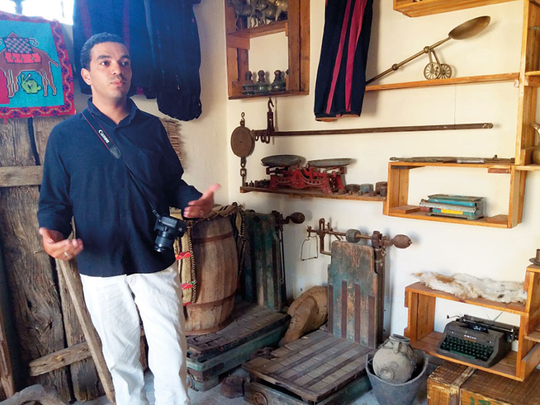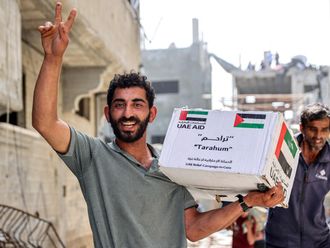
Gaza: Mohammad Abu Lehya and Najlaa Abu Nahla, a couple residing in the southern Gaza town of Al Qarara, have taken the unusual step of starting a private museum in a rented house after spending years collecting a number of artefacts and antiques.
In 2017 the couple founded Al Qarara Cultural Museum to preserve objects of artistic, cultural and historical importance in their town. Al Qarara is a rural area where the majority of residents rely on agriculture as the primary source of income.
Abu Lehya, an artist at the Culture and Free Thought Association, an NGO, married Abu Nahla in 2013; both are fine arts graduates.
“It is a common belief here that Al Qarara is a [relatively] new town. But the artefacts we’ve collected over the years prove otherwise,” Abu Nahla told Gulf News. She conducts educational and entertaining activities on fine arts for Al Qarara’s children at the museum.
Currently, the museum has about 2,000 objects ranging from artefacts, relics, antiques, traditional clothes and paintings. They go back to the Roman, Byzantine, Greek and early Islamic eras.
“Every day, farmers find some ancient objects while cultivating the land. But they usually throw them away because they don’t know what else to do [with them]. Worse, they break them in the process. It is sad that the authorities do not bother to collect them despite the fact that these are lying close to the surface,” said Abu Lehya.
Childhood passion
His passion for archaeology started when he was only 12. On his way to school, he often encountered neglected artefacts such as ancient pottery, bones, stones and coins on the sides of the streets, which sparked his interest.
Fadel Al Outel, an archaeologist in Gaza and a representative of Biblique Academy in occupied Jerusalem, said archaeology is not a priority for the authorities in Gaza. All the funding — especially after a 12-year siege — goes for relief, health and educational services.
Additionally, the number of students pursuing archaeology in university has dropped dramatically in the last few years. This is mainly due to the lack of decent job opportunities in the field. Ayman Hassouna, a professor in the Department of History and Archaeology at the Islamic University–Gaza, highlighted the danger, saying that in September, there were only five students studying history and archaeology – two men and three women.
Abu Lehya has been studying the craft for five years through reading and watching online YouTube videos as well as attending a 10-day practical course on the techniques of renovation and conservation. “My house turned into a bazaar, we had nowhere to walk,” Abu Nahla said.
After finding that there was no more space in their apartment for the artefacts, Abu Lehya decided to embark on the museum project. He rented an old house and renovated it in order to showcase all the artefacts, even as he collected more from the town’s residents.
Challenges
In the beginning, there wasn’t much enthusiasm among the public as such a venture was simply not a priority. Nevertheless, the couple decided to go ahead with the museum to preserve the richness of the place and offer some cultural activities, such as organising small celebrations on national holidays.
In the summer, they ran a camp for about 50 children to teach them about the history of Palestine and its capital, occupied Jerusalem, through fine art.
The camp was a success, as a result of which the children developed a connection with the place. This has resulted in them collecting metallic objects and coins while playing in the streets and handing them to the couple to be displayed in the museum. Abu Lehya and Abu Nahla plan to open a library in the future and expand the range of services.
They have approached the Ministry of Tourism and Archaeology for a licence for the private museum. It is still under process because Palestinian law does not cover any clear regulations or policies regarding private museums, as all the objects are registered as public property.
Self-funded
The museum has a total of 10 volunteers, including artists, a designer, and a photographer. The museum has so far cost the couple $10,000 (Dh36,700), an amount that has entirely been self-funded through their full-time jobs.
“When the Russian Consul visited the museum, he liked one of the coins and asked if he could take it. I firmly refused. I believe these belong to Palestine. The Palestinian security agent [accompanying the Russian consul] gave me a hug. I felt what I am doing is invaluable and meaningful. I was sort of proud. Also, my boss asked to move this museum to another town. I said no. I want this museum to be dedicated to Al Qarara town,” Abu Lehya said.
Gaza blockade
The 10-year blockade of Gaza has impacted the development of the museum. The couple have been unable to purchase some chemicals needed for conserving the artefacts as the Israeli occupation regime has banned their entry into Gaza. As a result, they are forced to employ primitive means, which require extra time, effort and cost.
The couple plan to have the official opening ceremony in 2019 after being locally recognised as an NGO in order to be able to receive external funds. They both hope the museum will serve as a free space to express Palestinian identity and history, especially given that many Al Qarara residents are uneducated.
“I dream this place would someday lead to an intellectual revolution in the area,” Abu Nahla said.
Wajiha Al Abyad is a freelance journalist based in Gaza










